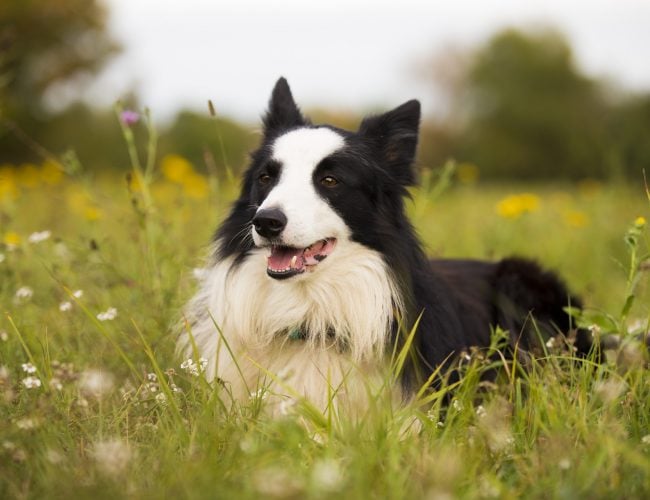Can Dogs Eat: Vegetables and Other Foods
Just like fruits and other human food, you may feel inclined to share some of the vegetables on your plate with your dog. Sometimes that face is simply too hard to say no to!
However, just like any other human food group, vegetables can be possibly dangerous to your dog’s health and digestive system.
A human’s nutritional needs vary greatly from a dog’s everyday diet. A person should include fruits and vegetables (among other food groups) into their meals every single day, however, it isn’t necessary for a dog to be eating either as a part of their diet. Let’s take a look at some of the most common vegetables pet owners are curious about feeding their dog as a small treat.
And if you’re not interested in feeding your dog real vegetables, try this fun toy as an alternative!

Smartest Dog Breeds
- If you need someone to take the SATs for you, we have you covered
- Intelligence is something you're born with. And these ones were.
EXPLORE SMARTEST DOG BREEDS

Family Dog Breeds
- They have the right patience and temperament for your family
- Vigilant and loyal, these dogs will protect their own
EXPLORE FAMILY DOG BREEDS
Vegetables
The answer to this one is yes! Dog’s can safely eat asparagus since this particular vegetable is not toxic to their bodies, however, feeding your dog asparagus comes with some caveats to consider.
As most have recognized, dogs tend to get excited when they are fed, let alone given some human food from the grown-ups table. It’s smart to cut the asparagus into smaller pieces before giving it to your dog to avoid them wanting to swallow it whole and choking.
Raw asparagus can be especially difficult to chew as well. You may want to consider cooking the asparagus lightly to soften it up before feeding it to your pup. When boiling or steaming the asparagus, do not use any butter or oil. Both of those, in addition to eating asparagus raw, can cause your dog to get sick.
If your dog responds by vomiting, passing gas, or getting diarrhea, avoid giving it to them again. Just like every human body can respond to food differently, dogs’ bodies can too!
In this instance, yes! You can feed your dog any color of bell pepper and it will not be toxic to your dog, whether it’s yellow, green, red, or orange.
If you’re feeding your dog bell peppers for nutritional value, then red bell peppers are your best option. All bell peppers contain various essential nutrients for both humans and dogs, however, red bell peppers are the ones with the highest levels of vitamins and antioxidants. There are additional health benefits you can find in bell peppers since they are so rich in vitamins. Some vitamins you can find include:
- Vitamin E
- Vitamin A
- Vitamins B6
- Vitamin C
- Lutein
- Beta-Carotene
All of these antioxidants play an important role in your dog’s healthy immune system. One of those antioxidants known as beta-carotene transforms into vitamin A, and in turn, helps parts of your dog’s body such as their skin, eye, and coat health. Just be sure to introduce your dog to bell peppers slowly and in moderation just like any other human food. Overeating anything can cause your dog indigestion. Also, be sure to cut them into small pieces and avoid any sort of seasoning. Spicy additives can be harmful to your dog’s stomach as well.
We feel like brussel sprouts are either loved or despised by those who try them. It may be the same for your dog. You’re able to feed your dog brussel sprouts, however, there are a few important precautions to be aware of. Some of the cons to feeding your dog brussel sprouts include:
- Large amounts of gas
- Upset stomach
- Diarrhea
- Flatulence
Now that you know the few downsides to feeding your dog brussel sprouts, let’s take a look at some of the advantages to feeding your dog this vegetable (in moderation of course). Some pros are that brussel sprouts contain multiple nutrients such as:
- Vitamin K
- Vitamin A
- Vitamin C
- Vitamin B1
- Vitamin B6
- Fiber
A vitamin such as K can aid in healthy bones, blood clotting properly, and other heart benefits. Other antioxidants included in brussel sprouts help reduce inflammation and increase blood circulation. As you can see, there are plenty of reasons to appropriately feed your dog this vegetable, however, there are some better ways to prepare them than others. It’s best to boil, microwave, or steam your brussels before letting your dog dig in! Some know that when you cook food, you actually lessen its nutritional value. Steaming your brussels is a great way to keep those nutrients intact. Just like lettuce, be sure to thoroughly wash off any chemicals that may be lingering on those vegetables to avoid any sort of sickness.
Cucumbers and lettuce can be similarly compared in regards to nutritional value: there’s not much they contain apart from water. They do, however, have some good vitamins that can be of benefit for humans and dogs.
In general, yes, you are able to feed your dog lettuce but you need to be aware of the lettuce type and the portion size you’re allowing your dog to eat. Some lettuce such as iceberg, romaine, and arugula are made up of 90% water.
Other acceptable kinds of lettuce to offer your dog are kale, collard greens, spinach, and arugula. Leafy greens like this can be beneficial because of the vitamin C and K it contains. Nonetheless, all lettuce needs to be given to dogs in moderation to avoid any kind of gastrointestinal issues.
Just like asparagus, it is better to cut the lettuce you’re giving your dog into smaller pieces. Lettuce can contain high amounts of fiber, making it quite hard for your dog to digest. It’s also crucial for you to thoroughly wash your lettuce before feeding it to your dog (or yourself).
You can put you and your pet at risk for various diseases such as listeria and E. coli if your lettuce is contaminated and not washed properly.
Olives are another vegetable considered non-toxic to dogs as long as it’s offered in moderation. Just like the other vegetables we’ve covered today, there are some positive and negative effects to your dog consuming olives.
On one side, olives are high in sodium, can contain garlic (highly toxic to your dog’s body), and contain olive stones that are choking hazards. But on the other hand, olives are rich in various vitamins and antioxidants. For one, olives include high levels of Vitamin E and “good fats” that help lower a dog’s cholesterol and blood pressure.
One of the fats we’re referring to is called monounsaturated fat. Monounsaturated fat is known to reduce inflammation. If your dog doesn’t experience inflammation, then they are less likely to encounter age-related arthritis as they get older!
Olives are also a great source of protein, calcium, vitamin A, vitamin, E, and vitamin K. All of these powerful nutrients improve your pet’s bone health and coat condition. In addition, olives may play a role in helping your dog fight off different kinds of cancer.
Another common question that comes along with feeding a dog olives is whether or not green and black olives are both safe.
Rest assured that black and green olives share almost all of the exact same qualities, therefore making them both edible to your furry friend.
If you’re anything like us, you absolutely love pickles! And if you have a pet, then you already know to expect some begging by the dinner table from that potent dill and vinegar smell.
In general, plain dill pickles are non-toxic to dogs, so you’re able to share them in small doses. However, pickles come in many different flavors and that is when you should completely avoid ever letting your dog eat pickles. Certain herbs and high amounts of sodium can be quite harmful to their health. High sodium levels can affect pre-existing health issues in your dog such as high blood pressure and they can also play a major role in your dog’s weight gain.
Some examples of harmful pickles you should not feed your dog are kosher dill pickles and bread and butter pickles. These pickle variants contain spices such as garlic that can upset your dog’s stomach and cause gastrointestinal issues. One smart suggestion is to just share small amounts of regular cucumber with your dog to avoid any unnecessary illness or worry.
Cucumbers are extremely low calorie, give your dog a nice crunchy snack, and help with hydration. However, if you opt in to sharing a pickle, only share ones that contain cucumber, brine, vinegar, and dill. Dill is supposedly known for helping out your dog’s breath!
Yes, zucchini is another vegetable you’re able to safely feed your dog. Just like most of the vegetables, we listed above, zucchini’s hold a lot of benefits when consumed in moderation! However, just to reiterate, never feed your dog human food that has seasoning and spice added to it when cooked or given raw. Instead, prepare the zucchini by cutting off the stalk, steaming or boiling it with water, and then chopping it into small pieces. Give your dog a few bites and see if he/she enjoys that mild zucchini taste. If they seem to enjoy it, their bodies are actually receiving numerous benefits. Some of those benefits include:
- High amounts of antioxidants and other nutrients
- Good snack for weight loss
- Assists will digestion if your dog is constipated
Carotenoids are one of the abundant antioxidants found in a zucchini that helps give it its color. Most of those antioxidants live in the zucchini’s skin, so try to refrain from peeling that off before feeding it to your dog. The skin is also an awesome source of fiber for them as well! Other vitamins and minerals you can find in zucchinis include vitamin A, vitamin C, vitamin K, vitamin B6, manganese, copper, magnesium, phosphorus, potassium, and zinc. That’s a whole lot when you think about it! Just be sure to always clean your vegetable, cut it in small pieces, and properly portion the amounts you give your dog to avoid stomach irritation.

Hypoallergenic Dog Breeds
- Low shedding dogs that will attack the allergies less
- These dogs come in all shapes, sizes and temperaments
EXPLORE HYPOALLERGENIC DOG BREEDS

Cute Dog Breeds
- I mean, come on. These dogs will have you wanting one.
- Guaranteed to make you instagram famous (or at least your pup!)
EXPLORE CUTE DOG BREEDS

Hunting Dog Breeds
- Energy and a willingness to get the job done, these dogs love outside
- Their traits and unique skillsets have them separated from the pack
EXPLORE HUNTING DOG BREEDS

Companion Breeds
- Their loving and caring spirit makes them great compadres
- A passion for giving back to their owner is in their DNA
EXPLORE COMPANION DOG BREEDS
All Dog Breeds Lists
- From family to hairless to sled dogs, we have you covered
- All breeds from the ones you know, to the ones you don't
EXPLORE DOG BREEDS

